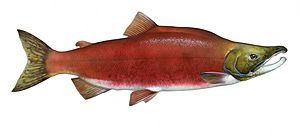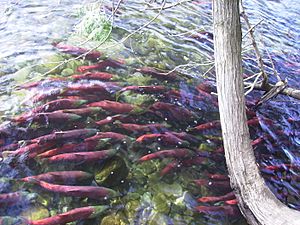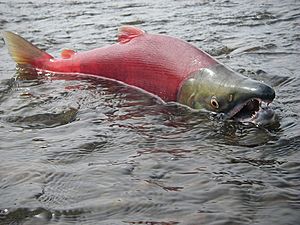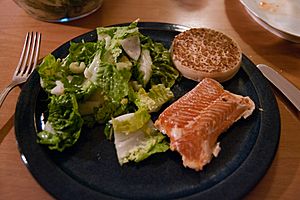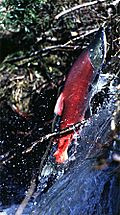Sockeye salmon facts for kids
Quick facts for kids Sockeye salmon |
|
|---|---|
 |
|
| Sockeye salmon in their bright spawning colors | |
| Conservation status | |
| Scientific classification | |
| Genus: |
Oncorhynchus
|
| Species: |
nerka
|
The sockeye salmon (Oncorhynchus nerka) is a fascinating fish. It's also known as red salmon or kokanee salmon. These amazing fish live in the Northern Pacific Ocean and the rivers that flow into it. Sockeye salmon are special because they are anadromous. This means they are born in freshwater rivers, travel to the ocean to grow, and then return to freshwater to have their own babies. When they return to spawn, their bodies turn a bright red color! They can grow up to 84 centimeters (about 2.7 feet) long and weigh between 2.3 to 7 kilograms (5 to 15 pounds). Young sockeye salmon stay in freshwater for a while. Then they make long journeys, sometimes over 1,600 kilometers (1,000 miles), to the ocean. Their main food is tiny water creatures called zooplankton. After having their babies, sockeye salmon complete their life cycle. Some sockeye, called kokanee, live their whole lives in freshwater lakes and never go to the ocean.
Contents
- Discovering the Sockeye Salmon's Name
- What Does a Sockeye Salmon Look Like?
- Where Do Sockeye Salmon Live?
- What Do Sockeye Salmon Eat?
- The Amazing Life Cycle of Sockeye Salmon
- How Sockeye Salmon Reproduce
- Competition Among Sockeye Salmon
- Sockeye Salmon: Fishing and Food
- Protecting Sockeye Salmon
- Images for kids
- See also
Discovering the Sockeye Salmon's Name
The sockeye salmon is one of the most common types of Pacific salmon. It comes after pink and chum salmon. Its scientific name, Oncorhynchus nerka, has interesting roots. Oncorhynchus comes from ancient Greek words meaning 'bend' and 'snout'. The word nerka is the Russian name for this type of salmon. The name "sockeye" comes from the Halkomelem language. This language is spoken by indigenous people along the Fraser River in British Columbia. In their language, "suk-kegh" means 'red fish'. This is a perfect name for them when they turn red to spawn!
What Does a Sockeye Salmon Look Like?
Sockeye salmon are often called red or blueback salmon because of their colors. When they live in the ocean, they are blue with silver sides. But when they swim back to their spawning grounds, their bodies change. They turn a vibrant red, and their heads become green! These fish can be from 60 to 84 centimeters (2 to 2.7 feet) long. They can weigh from 2.3 to 7 kilograms (5 to 15 pounds). Two special features help identify them. They have long, comb-like structures called gill rakers inside their mouths, usually 30 to 40 of them. Also, they don't have any spots on their tails or backs.
Where Do Sockeye Salmon Live?
Sockeye salmon live across a wide area. In the eastern Pacific, they are found as far south as the Columbia River. Some have even been seen off the coast of California. In the western Pacific, they live as far south as northern Hokkaido in Japan. To the north, they reach the Bathurst Inlet in the Canadian Arctic and the Anadyr River in Siberia. Some sockeye salmon travel incredibly far inland. For example, they reach Redfish Lake, Idaho. This journey is over 1,450 kilometers (900 miles) by river from the ocean. It also involves climbing 1,980 meters (6,500 feet) in elevation! Sadly, some sockeye populations have disappeared from places like Idaho and Oregon in the United States.
Sockeye Salmon That Live in Lakes
Some sockeye salmon populations never go to the ocean. They live their whole lives in freshwater lakes. These lake-dwelling sockeye are often called kokanee. This name also means "red fish" in some Interior Salish languages. Kokanee are much smaller than their ocean-traveling relatives. They are rarely longer than 35 centimeters (14 inches). In some lakes, like Okanagan Lake, there are two types of kokanee. One type lays its eggs in streams, and the other lays them near lake shores. You can find these landlocked populations in many places. This includes the Yukon and British Columbia in Canada. They are also in many US states like Alaska, Washington, Oregon, and Idaho. Nantahala Lake in North Carolina is the only place there where kokanee salmon live. They were introduced in the 1960s to provide food for other fish.
In Japan, there was a type of landlocked sockeye called black kokanee, or "kunimasu". People thought they were extinct after 1940. This was because a power project made their lake too acidic. But it seems the species was saved! Eggs were moved to Saiko Lake, 500 kilometers south. This fish is sometimes seen as a special kind of sockeye.
What Do Sockeye Salmon Eat?
Sockeye salmon are smart eaters. They move up and down in the water to find food. They also swim in groups and choose specific tiny creatures to eat. They can change where they swim and when they eat. This helps them avoid predators and still get enough food. All these behaviors help the salmon survive and stay healthy. How aggressively they hunt can change depending on where they are and how many predators are around.
Unlike other Pacific salmon, sockeye salmon eat a lot of zooplankton. They eat these tiny animals when they are in both freshwater and saltwater. They also enjoy small water creatures like shrimp. When they are young, their diet also includes insects and sometimes snails.
The Amazing Life Cycle of Sockeye Salmon
Sockeye salmon have many different life stories. Most of them are anadromous. This means young salmon swim from freshwater lakes and streams to the ocean. They grow there and then return as adults to their home freshwater to spawn. Like most Pacific salmon, sockeye salmon are semelparous. This means they have babies only once and then they die. Some sockeye, called kokanee, stay in freshwater lakes their whole lives. Most sockeye lay their eggs in rivers near lakes. The young fish then spend one to two years in the lake. After that, they migrate to the ocean. Some populations go to saltwater in their first year. Adult sockeye spend two to three years in the ocean. Then they return to freshwater. Females lay their eggs in 3 to 5 nests, called redds, over several days. The eggs usually hatch in six to nine weeks. The baby fish, called fry, typically grow in lakes before heading to the ocean.
How Sockeye Salmon Reproduce
Male sockeye salmon compete to find a mate. They might form groups around females ready to lay eggs. Some males are larger and have more noticeable features. These males often have more success in having young. Females' success depends on how many eggs they lay. It also depends on their body size and how well their eggs survive. The quality of the nest they build is also important. Males' locations depend on chances to mate and the best places to build nests.
Smaller, less dominant males might stay near mated pairs. When the female lays eggs, these males might quickly join in to release their sperm. Other dominant males from nearby nests might do this too. Larger males with bigger humps on their backs tend to be more successful. Larger females often lay eggs in shallower water, which is a preferred spot.
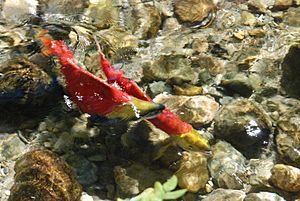
Males and females look very different when they are ready to have babies. Males develop deeper bodies, taller humps, and longer snouts. Females also get longer snouts. But their humps and other fins don't grow as much. This suggests that longer snouts might help them attract mates. Females develop large organs for producing eggs. These can be about 25% of their body weight.
Female salmon are responsible for caring for their young. They choose, prepare, and protect a nest site. They do this until they die or are forced away. Males do not help with parental care. They move between females after the eggs are laid.
Choosing Mates and Surviving in Nature
Both large males and females are favored when it comes to having babies. Males choose females based on their size and readiness to lay eggs. This helps them have the most chances to mate. Larger females can lay more and bigger eggs. They can also choose better nest spots and defend them. They can bury their eggs deeper, offering more protection. Females also tend to mate faster with larger males. This increases the chance that bigger males will take over from smaller ones. Larger male sockeye salmon are more successful in competing with other males and being chosen by females. Males prefer to mate with red females, which is their usual color. Even small differences in color can affect their choice.
Some traits that help salmon have babies, like body size, can also affect their survival. This creates a push and pull between how they choose mates and how they survive in nature. Larger males are usually preferred. But if there are many predators, being large can be risky. Sockeye salmon that die early from predators are often the largest ones. This shows that nature sometimes favors smaller bodies. Populations with more predators tend to become smaller over time. If there are no predators, salmon that lay eggs early in the season live longer than those that lay eggs late.
Other natural factors, like getting stranded, also favor smaller sockeye salmon. Stranding happens when salmon swim onto dry land or into very shallow water during their journey to lay eggs. They then die from not being able to breathe. Studies show that the largest sockeye salmon are most likely to get stranded and die.
The Energy Challenge of Reproduction
Having babies takes a lot of energy for sockeye salmon. They use up their stored fat and protein. This happens from their last moments in the ocean, through their journey into freshwater, and until they lay eggs and die. Sockeye salmon do not eat during this time. They stop eating once they enter freshwater, which can be months before they lay eggs. The baby salmon inside the eggs survive on their own stored food for about 3 to 8 months. So, sockeye salmon must complete their reproduction using only the energy they brought to the spawning grounds. How they use this energy during their journey and spawning affects how many babies they can have. Energy used for swimming long distances cannot be used for finding a mate. If they use too much energy, they might not be able to lay eggs. Males also have to decide whether to use energy fighting for a female or to save it to live longer on the spawning grounds. Sockeye salmon with longer and harder journeys lay fewer eggs. High water temperatures also make them use more energy as they swim upstream.
Competition Among Sockeye Salmon
Dominant male sockeye salmon often act aggressively towards other dominant males that try to get close. Sometimes, they also act aggressively towards smaller males. These fights are usually short. The intruding male leaves after one or two quick interactions. Females who are laying eggs mostly act aggressively towards other females who come too close. But they might also chase away intruding males. Fights between females are also short, with one or two charges or chases. The intruder swims away, and the female returns to her nest. These aggressive actions are important. They help females get good nest sites and access to males.
Young sockeye salmon can also compete for food or space in lakes. This happens when there are many young salmon or when different age groups are present. It also occurs when there isn't much food available. Sometimes, sockeye salmon compete with other fish species. This can lead to them changing their diet or habitat to avoid competition. Competition with other species can slow down the growth of salmon if they have less access to food.
Sockeye Salmon: Fishing and Food
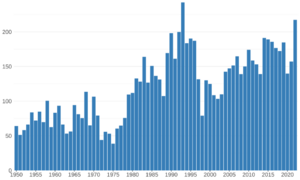
Sockeye salmon are very important for fishing and as food. In 2010, about 170,000 tonnes of sockeye were caught worldwide. The United States caught 115,000 tonnes, and Canada and Russia shared the rest. This was about 65 million fish! It made up about 19% of all Pacific salmon caught that year.
Commercial fishermen in Alaska catch sockeye using large nets. They sell them fresh, frozen, or in cans. The annual catch in Bristol Bay, Alaska, can reach 30 million fish. This is the largest sockeye harvest in the world.
Sockeye salmon have always been a vital part of the diet and culture of the Coast Salish people in British Columbia.
The biggest spawning grounds in Asia are on the Kamchatka Peninsula in the Russian Far East. The Ozernaya River of the Kurile Lake alone accounts for almost 90% of all Asian sockeye salmon. It is known as the largest spawning ground outside of Alaska. There are concerns about illegal fishing in Kamchatka.
Sockeye salmon are almost never raised on farms. However, a facility in Langley, BC, started harvesting farmed salmon in March 2013. They continue to raise salmon in their inland facility.
Protecting Sockeye Salmon
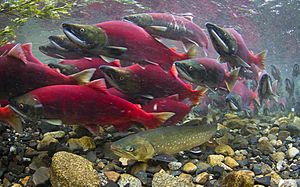
United States Conservation Efforts
Some sockeye salmon populations in the United States are protected. The National Marine Fisheries Service lists them under the US Endangered Species Act. The Snake River sockeye salmon are listed as endangered. The Lake Ozette, Washington, population is listed as threatened. The Snake River sockeye salmon became endangered in November 1991. This happened after the Shoshone-Bannock Tribe asked for their protection.
In 2010, there was an unexpected increase in sockeye salmon returning to the Columbia River. On July 2, 2010, the United States Army Corps of Engineers reported over 300,000 sockeye had passed over Bonneville Dam. This was much higher than expected. Colder waters in the North Pacific in 2008 brought more plankton. This, along with more water flowing from the Columbia River, helped these populations grow.
Laws like the Northern Rockies Ecosystem Protection Act aim to protect the areas where sockeye salmon begin their lives. They do this by preventing building in untouched natural areas.
Record numbers of sockeye salmon returned to the Northwest's Columbia Basin in June 2012. Thousands more crossed the river's dams in a single day than in some previous years.
Canadian Conservation Efforts
The health of sockeye populations in Canada is being checked by Fisheries and Oceans Canada. This is part of their plan to monitor wild salmon. Important salmon runs include those in the Skeena and Nass rivers. The most famous is the Fraser River sockeye run.
The Fraser River salmon run saw fewer fish returning since the 1990s. This was similar to a decline in the 1960s.
In 2009, the number of Fraser River sockeye returning was very low, estimated at 1,370,000. This was only 13% of what was predicted. It was a big drop from the 1993 peak of 23,631,000 fish. This return was the lowest in over 50 years. The reasons for this decline were unclear. Scientists gathered to study the problem. They noted how hard it is to predict salmon returns.
After the low returns, the Canadian government started an official investigation. It was called the Commission of Inquiry into the Decline of Sockeye Salmon in the Fraser River.
The Commission looked into all factors that might affect Fraser River sockeye salmon. They studied environmental changes in the Fraser River. They also looked at ocean conditions, fish farms, predators, diseases, and water temperature. They examined other factors that might have stopped salmon from reaching their spawning grounds or the ocean.
During the commission, many documents and scientific papers were reviewed. Twelve technical reports were published. These reports looked at possible impacts from diseases, hatchery diseases, pollution, ocean life, salmon farms, fishing, predators, climate change, and government management. All these factors could affect the Fraser River sockeye runs.
While the commission was working, in the late summer of 2010, the largest run of sockeye since 1913 returned to the Fraser River system. Final counts showed about 30 million salmon returned in 2010. Canadian fishers caught about 11,591,000 Fraser sockeye. American fishers caught 1,974,000. The number of fish that were not caught and made it to spawn was about 15,852,990.
Recent changes in the number of returning salmon might be due to changing water temperatures. Different sockeye salmon populations in the Fraser River have different abilities to handle warm water. The Chilko River sockeye salmon can keep their heart and breathing working well at higher temperatures. This might help them deal with rising river temperatures. Studies have looked into why these populations are different. However, the exact reasons for these differences in handling warm water are still being studied.
Images for kids
See also
 In Spanish: Salmón rojo para niños
In Spanish: Salmón rojo para niños



